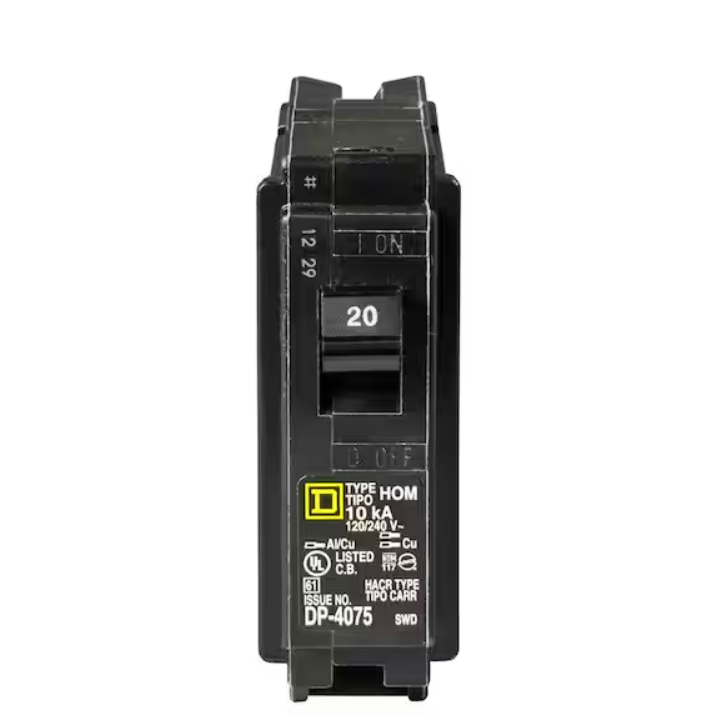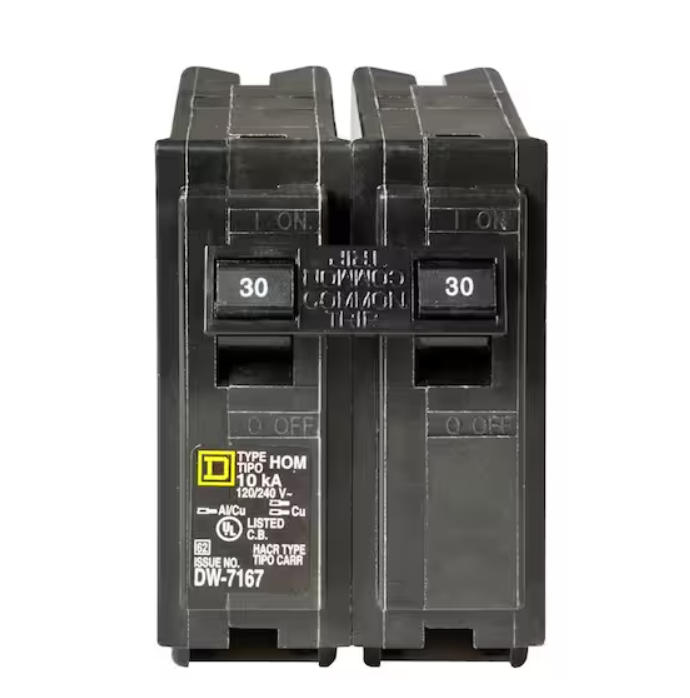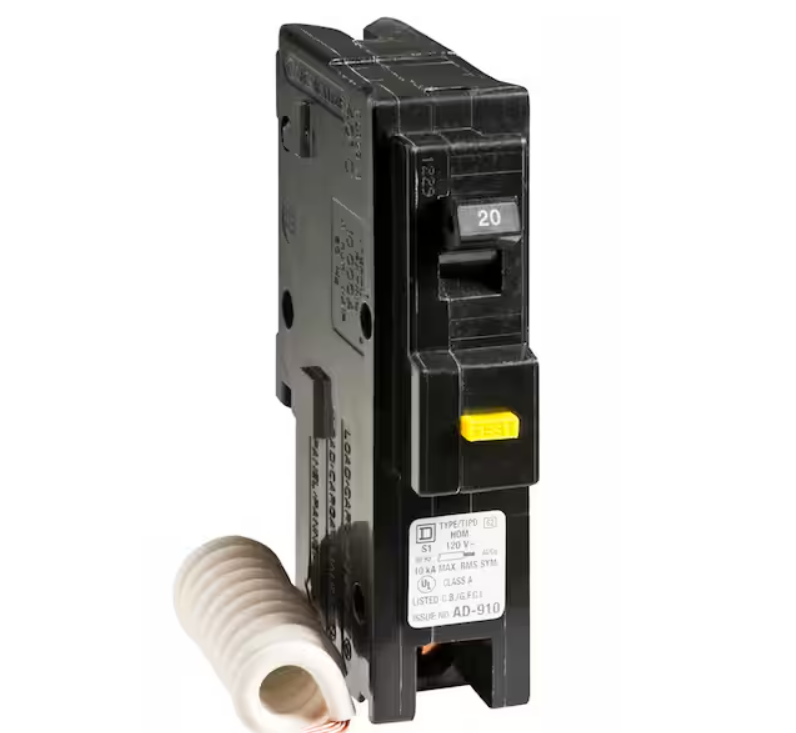
Square D Homeline 2-20 Amp Single-Pole Tandem Circuit Breaker
- learn about general NEC 2020 updates. contact your local building inspector for code adoptions and details
- Plug-on design, easy to install
- Compatible with Square D Homeline load centers and CSED devices

Square D Homeline 30 Amp 2-Pole Circuit Breaker(HOM230CP)
- learn about general NEC 2020 updates. contact your local building inspector for code adoptions and details
- Homeline 30 Amp two-pole circuit breaker
- Plug-In design, easy to install

Square D Homeline 20 Amp Single-Pole Plug-On Neutral Dual Function (CAFCI and GFCI) Circuit Breaker
- learn about general NEC 2020 updates. contact your local building inspector for code adoptions and details
- Homeline 20 Amp single-pole plug-on-neutral dual function (CAFCI and GFCI) circuit breaker

Square D Homeline 20 Amp Single-Pole GFCI Circuit Breaker
- learn about general NEC 2020 updates. contact your local building inspector for code adoptions and details
- Square D Homeline 20 Amp 1-pole GFCI circuit breaker
- Plug-on design, easy to install

Square D Homeline 20 Amp Single-Pole Circuit Breaker(HOM120CP)
- Installation Guide
- Homeline 20 Amp one-pole circuit breaker
- Plug-In design, easy to install
- Switching duty rating (SWD) for 20 Amp one-pole breakers
Your Go-To Resource for Square D Circuit Breakers
Circuit breakers are an essential part of any electrical system, protecting wiring and devices from damage due to overloads and short circuits. As one of the top manufacturers of circuit breakers, Square D is a trusted brand used in homes, businesses, and industrial facilities across North America.
But with so many types and models available, choosing the right Square D circuit breaker for your specific needs can seem daunting. This comprehensive buying guide covers everything you need to know about selecting, installing, and using Square D breakers for optimal performance and safety.
What Are Square D Breakers Used For?
Square D manufactures a wide variety of circuit breakers for both residential and commercial/industrial applications. Their breakers are designed to safely and efficiently distribute power and provide overload/fault protection for:
- Home electrical systems
- Lighting circuits
- Appliances and electronics
- HVAC equipment
- Pumps and motors
- Industrial machinery
- Data centers
- alternative energy systems
Common types of Square D breakers include:
- Single-pole – interrupt one conductor
- Double-pole – interrupt two conductors
- GFCI (Ground Fault Circuit Interrupter) – detect dangerous ground faults
- AFCI (Arc-Fault Circuit Interrupter) – detect dangerous arcs
- Tandem/Duo – allow multiple circuits in one breaker space
How Do Square D Breakers Work?
Square D circuit breakers operate by monitoring the electrical current flow through the circuit and tripping (interrupting flow) if certain thresholds are exceeded. They work via:
- Overcurrent detection – If current exceeds rated amperage, magnetic solenoid trips breaker
- Overload/time-delay – If current elevated over time, breaker will trip to prevent overheating
- Short circuit/instantaneous – Excessive current trips breaker immediately
- Ground fault detection (GFCI models) – Trips if current detected leaking through ground
- Arc fault detection (AFCI models) – Trips when dangerous arc detected
When tripped, the breaker switches to the “off” position, stopping the flow of power. Simply switching the breaker back “on” resets it once the issue is resolved.
Why Choose Square D Breakers?
There are plenty of reasons Square D breakers stand out from other brands:
- Reliability – Proven, time-tested performance and durability
- Safety – Advanced trip technology and certifications for safety
- Code compliance – Meets all NEC requirements for circuit protection
- Trusted brand – Square D has 100+ years experience manufacturing breakers
- Variety – Models for nearly any residential, commercial or industrial application
- Warranties – Strong product warranties when installed properly
- Compatibility – Designed for seamless use with other Square D equipment
For maximum safety and performance, Square D is an ideal choice for circuit breakers over “no name” brands.
Where Can I Buy Square D Breakers?
Square D breakers are sold through:
- Electrical supply and equipment retailers – Widest selection of Square D breaker types and amperages
- Home improvement stores – More limited options, often best for common residential models
- Online retailers – Order conveniently online and have breakers shipped to you
- Wholesale electrical distributors – Offer discounted pricing for volume orders
When purchasing, always buy new, unused breakers still in factory packaging. Avoid used or refurbished breakers which may be unreliable. An electrical supply retailer that specializes in Square D products is often the best source for expert advice and help choosing suitable breakers.
Which Square D Breaker Do I Need?
Selecting the proper Square D circuit breaker involves considering:
- Type – 1-pole, 2-pole, GFCI, AFCI, etc. Basic single-pole for lighting/outlets, 2-pole for 220V appliances.
- Amp rating – Match breaker amperage to circuit wires. Standard is 15 or 20 amps for homes.
- Voltage – Match voltage (120VAC or 240VAC usually).
- Interrupting rating – 10,000 Amps is typical for homes; higher for commercial/industrial.
- Terminations – Connector type compatible with service panel.
- Physical size – Breaker width/height must match panel space.
- Applicable standards – NEC codes, UL certification, AHRI, etc.
Refer to the existing breaker, nameplate ratings on appliances/equipment, and installation manuals to determine specifications. When in doubt, consult an electrician.
How to Install Square D Breakers
Caution: Always switch power OFF at the main breaker before installing new breakers. Follow these general steps:
- Switch main breaker OFF for safety. Verify power is off.
- Remove panel cover plate.
- Compare new breaker to old one. Make sure matching size, amps, poles, voltage.
- Connect wires to new breaker properly – match previous setup. Tighten terminals securely.
- Carefully insert new breaker into panel slot until seated firmly.
- Switch main breaker back ON, then new breaker to ON position. Test operation.
- Replace cover plate securely before turning power back on.
Always follow manufacturer instructions. Use caution working inside a live panel. Call an electrician if you are ever unsure about safely installing a new circuit breaker.
Are Square D Breakers Interchangeable?
Square D offers different product families that are designed for interchangeable use including:
- Homeline – Home residential applications
- QO – Advanced protection and connectivity
- NQ – Compact residential/light commercial
- NG – General duty light commercial
Breakers within one family typically share common case sizes, connectors, and terminations allowing interchangeable use. However, you should always verify technical specifications before swapping different model breakers. Never install a breaker not approved for use in that specific panel – contact Square D for guidance.
How to Reset a Tripped Square D Breaker
- Locate the breaker that has “tripped” to the middle OFF position.
- Unplug all appliances on the circuit protected by the breaker.
- Inspect for any signs of damage, overloading, or shorts.
- Flip breaker to OFF, then back ON. Should reset with a “click”
- Plug in appliances one at a time, allowing time between each.
- If breaker trips again, there is likely still an overload/short present on the circuit.
Call an electrician immediately if the breaker continues to trip and the cause is unclear for your safety. Do NOT bypass a tripped breaker with a penny or other “cheater” method – this a major fire hazard.
What is the Warranty on Square D Breakers?
When installed in accordance with specifications, Square D breakers are backed by a limited warranty up to 2 years from date of purchase. This covers defects in materials and workmanship. However, problems due to improper installation/use are not covered.
Always keep your sales receipt as proof of purchase date and confirm warranty details with your local Square D supplier. Registering your purchase may also extend or enhance warranty terms. Authorized Square D repair/replacement is the exclusive remedy under their factory warranty.
How to Identify Square D Breaker Types
Square D breakers feature clear markings to identify ratings, certification, and compliance. Key markings include:
- Amperage – rated current capacity
- **Voltage ** – voltage suitable for (120V, 240V, etc)
- Poles – single, double, triple pole configurations
- Short circuit rating – 10kA typical minimum
- Certification – UL/CSA/NOM for North American standards
- Product family – Homeline, QO, NQ, etc.
- Compliance – standards such as NEC, OSHA, NFPA, ROHS
- Date codes – date of manufacture
Learning how to read these identification markings is crucial for proper breaker selection and installation. Consult Square D labeling guides for details on markings.
Can Square D Breakers Be Used Outdoors?
Most standard Square D breakers are designed for indoor installation only. Using them in wet, damp, or corrosive environments can cause premature failure and poses safety risks from electrical shorts/fires.
However, Square D does offer breakers specifically rated for outdoor and weather-resistant applications including:
- Qwik-Gard line of breakers
- Homeline outdoor breakers
- Arc-Fault circuit breakers with weatherproof covers
- NEMA 3R rated enclosures for outdoor panels
These feature sealing, protective coatings, and waterproofing for reliable outdoor performance. Always verify breakers are rated and listed for outdoor installation by Square D.
What is the Price Range for Square D Breakers?
Expect to pay $10 – $100+ per breaker depending on:
- Amp/pole configuration – higher capacity or poles cost more
- Circuit breaker type – basic vs GFCI/AFCI with more complex operation
- Single vs. bulk pricing – bulk/volume discounts often available
- Where you purchase – online, specialty electrical suppliers, home stores
On average, basic single pole 15-20 amp residential breakers run $10 to $30 new from an electrical supply store. Larger amperage or technologically advanced Arc-Fault/Ground-Fault breakers range from $50 to over $100. Buying multi-pole breakers, bulk quantities, or starter packs can lower per-unit pricing considerably.
How to Troubleshoot a Square D Breaker Tripping
A Square D breaker that trips frequently or unexpectedly can result from:
- Overloaded circuit – Too many appliances/devices exceeding capacity
- Short circuit – Damaged wiring causing hot/neutral contact
- Loose connections – Overheating from high resistance at terminals
- Moisture/corrosion – Wet environment causing leakage
- Old age – Wear causing delayed tripping
- Wrong size breaker – Breaker amperage too high for wire size
- Damaged breaker – Internal components malfunctioning
Isolate the problem by unplugging appliances one-by-one. Inspect connections for signs of burns or pitting. Exercise breaker contacts and check for debris. If the issue persists, hire an electrician to thoroughly inspect and test the breaker.
What Sizes Do Square D Breakers Come In?
Square D circuit breakers for residential applications are commonly available in these pole configurations and amperages:
- 1-pole: 15A, 20A, 25A, 30A, 35A, 40A, 45A, 50A, 60A
- 2-pole: 15A, 20A, 25A, 30A, 35A, 40A, 45A, 50A
- 3-pole: 15A, 20A, 25A, 30A, 35A, 40A
They also offer intermediate amp ratings and larger sizes exceeding 60A for commercial and industrial uses.
Physically, common breaker size classifications are:
- 1″ wide – 15A, 20A single-pole
- 1.5″ wide – two-pole 15A, 20A and up
- 2″ wide – large amperage and pole configurations
Breaker width/height must match the panelboard space. Check manufacturer specs to select the proper size.
How to Replace a Square D Breaker
Follow these guidelines to safely replace an old Square D breaker:
- Turn OFF power at the main breaker and verify it is deactivated.
- Photograph panel wiring before removing old breaker for reference.
- Remove wire connections and pull old breaker from slot.
- Verify new breaker has identical specifications (amps, voltage, poles).
- Connect wires to matching terminals – line, load, neutral, ground.
- Carefully insert new breaker into slot until fully seated.
- Restore main breaker and switch panel back on. Test operation.
- Call an electrician if any complications arise during the replacement process for assistance.
Always exercise caution and follow Square D instructions when swapping breakers. Match specifications precisely to avoid hazards.
Are Square D Breakers Safe?
With a reputation spanning 100+ years, Square D is unquestionably one of the most trusted and safety-focused brands for circuit breakers. Their breakers meet the highest standards for performance and protection including:
- Rigorous UL/CSA/NOM certification for North American safety compliance
- Stringent internal testing to ensure flawless operation over the product lifetime
- Overcurrent trip settings to prevent overloaded wires from overheating
- Sophisticated fault interruption systems for fire/shock prevention
- Leading arc fault, ground fault, surge protection technologies
- Thermal and magnetic trip elements provide redundant protection
When installed per application listings and NEC/local codes, Square D breakers provide the highest level of safety. But improper installation can still result in hazards – professional electrician installation is recommended.
Do Square D Breakers Need Maintenance?
Square D circuit breakers are designed to be maintenance-free for years. But occasional inspection and testing is still recommended:
- Visually inspect for any cracked cases or damage. Replace breaker if found.
- Check tightness of all wire connections. Retorque loose connections.
- Exercise/cycle breaker to clean contacts and ensure smooth mechanical operation.
- Consider having an electrician perform resistance tests for any suspect breakers.
- Infrared scan panels to identify any hot spots on breakers.
Any breakers frequently tripping or not resetting properly after an overload should be replaced – do not attempt repairs. Follow Square D instructions for any breaker maintenance procedures.
How Long Do Square D Breakers Last?
With proper installation and maintenance, Square D breakers often last 25-40 years or more. Several factors affect overall lifespan:
- Application environment – moisture, corrosion, temperature extremes degrade breakers quicker
- Electrical loads – frequent tripping wears components faster
- Wiring system health – poor connections stress breaker over time
- Quality of installation – improper wiring damages components
- Usage class – light-duty residential vs heavy industrial duty cycles
- Age and wear – older models may lack modern materials/improvements
While a 40-year service life is not unusual, breakers exposed to harsh conditions or heavy loads may need replacement much sooner. Always have old breakers tested periodically and replace any malfunctioning units.
What is the Difference Between Square D Breakers and Other Brands?
Key differences between Square D and other breaker brands include:
- Square D offers advanced patented technologies for ground fault (GFCI) and arc fault (AFCI) protection. More reliable at detecting and interrupting dangerous faults.
- Extensive product range with breakers for virtually any residential, commercial or industrial application.
- Square D Homeline, QO, and other product families feature coordinated designs for seamless operation and interchangeability.
- Square D focuses heavily on continuous safety testing and improvement of product lines rather than lower cost manufacturing.
- Established reputation and proven performance record spanning over a century. Trusted brand.
- Robust warranties and support network of supply partners and field technicians to support Square D breakers.
Compare construction, features, and certifications closely when choosing between brands like Eaton/Cutler Hammer, Siemens, GE, etc.
How to Test a Square D Breaker
Important Square D circuit breaker tests:
- Contact resistance test – Use a milliohm meter to check contacts are in spec and not overheating.
- Insulation resistance test – Use a megohmmeter to verify insulation isn’t damaged.
- Continuity test – Confirm proper continuity on poles/conductors.
- Trip time test – Determine if breaker trips within expected timeframe during overload.
- Voltage test – Check if voltage drop/imbalance indicates loose/damaged connections.
- Mechanical test – Manually cycle breaker to check for smooth operation and reset.
Testing requires specialized equipment and knowledge for proper interpretation. Hire a certified electrician to thoroughly inspect and evaluate Square D breakers every 2-4 years or anytime breaker problems are suspected.
Conclusion
From homes to heavy industry, Square D circuit breakers provide the proven performance and safety that has made them an industry leader. This definitive buyer’s guide explores Square D breaker types, key specifications, installation, maintenance, and troubleshooting. Protect your family, facilities, and equipment by understanding exactly which Square D breaker models match your needs and how to use them properly. Thanks for reading!



